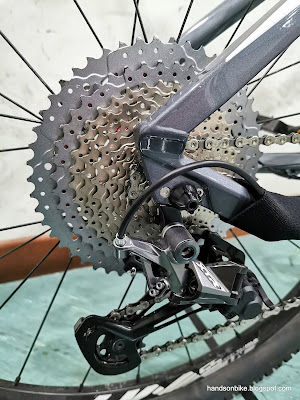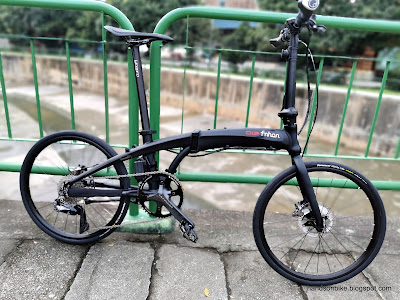I didn't want to spend money to upgrade the 26" rear wheel to have a Microspline freehub, as 26" wheels are considered obsolete in the MTB world. Although it still rides fine, I would rather spend money on getting a new MTB frame with 29" or 27.5" wheels.
Why would I want to change the S-Ride 12 speed cassette? That is because it has some flaws, which I hoped a better cassette would solve. For example, the shifting performance is not ideal when paired with the XTR 12 speed shifter and rear derailleur, as I think the spacing between the sprockets is not Shimano compatible. It does work OK when paired with the S-Ride 12 speed shifter.
The second reason is because the chain tends to derail from the sprocket during backpedaling. This happens in the lowest (largest) 2 sprockets, when the chain line is quite extreme. I have tried other bikes with a full Shimano 12 speed MTB groupset (XTR or Deore XT or SLX) and they don't have this backpedaling issue.
As Shimano does not make a 11-50T 12 speed cassette, I will have to look to other brands for 12 speed super wide range cassettes. SRAM Eagle 12 speed cassettes are also not compatible with my MTB, as a XD driver is needed on the rear hub. Therefore, I decided to get the Sunrace 12 speed MTB cassette to try out.
The Sunrace MZ90 12 speed cassette has a sprocket size of 11-50T, which is really wide, and it is compatible with standard freehub bodies. Although I don't get the 10T sprocket, I am fine with it as 11-50T range is already very big.
11-50T Sunrace MZ90 12 speed cassette. Looks pretty high end!
Gear steps: 28-32-36-42-50T. Big step from 42T to 50T. The 42T and 50T are made of aluminium for lower weight.
Gear steps: 11-13-15-17-19-21-24-28 and so on. Pretty standard gear steps.
Largest 4 sprockets are riveted together onto this massive red aluminium spider.
The largest 2 sprockets are cantilevered far out from the spider, enabling 12 sprockets to be squeezed onto the standard freehub body.
Next 3 sprockets (21-24-28T) are riveted onto the second spider.
Nothing special of note here.
All the 12 gear sprockets!
The red spacers are made of aluminium, which are usually only used on higher end cassettes.
There is even a free gift of the RD dropout extender with extra long B-tension bolt, in case you want to use your existing rear derailleur that is not rated to reach the large 50T sprocket.
Sunrace MZ90 11-50T 12 speed cassette assembled onto the bike! The red coloured spider is really eye catching.
Still looks enormous no matter how many times I see it.
Silver coloured sprockets match quite nicely with the XTR rear derailleur.
At gear 3, the RD cage is at its lowest point.
At the lowest gear (gear 1), the RD cage is fully stretched as shown.
Latest picture of the bike, with the Sunrace 12 speed cassette being the newest component on this bike.
The Sunrace cassette is a significantly big step up in quality, compared to the S-Ride cassette. First, the shifting performance is improved, as I think the gear spacing is more or less compatible to Shimano.
Also, there is no longer any chain drop from the sprocket, when I backpedal at the lowest 2 gears. This is due to some clever shaping and design of the sprocket teeth which helps to hold the chain onto the sprocket.
This Sunrace MZ90 12 speed cassette is not cheap (around SGD $110 from Taobao), especially for a cassette that is not from Shimano or SRAM. However, it is considered the best of the rest, and it seems to work well with these Shimano components. Overall, I would say it is a good upgrade, especially for older bikes that do not have the Microspline or XD freehub bodies.


































































